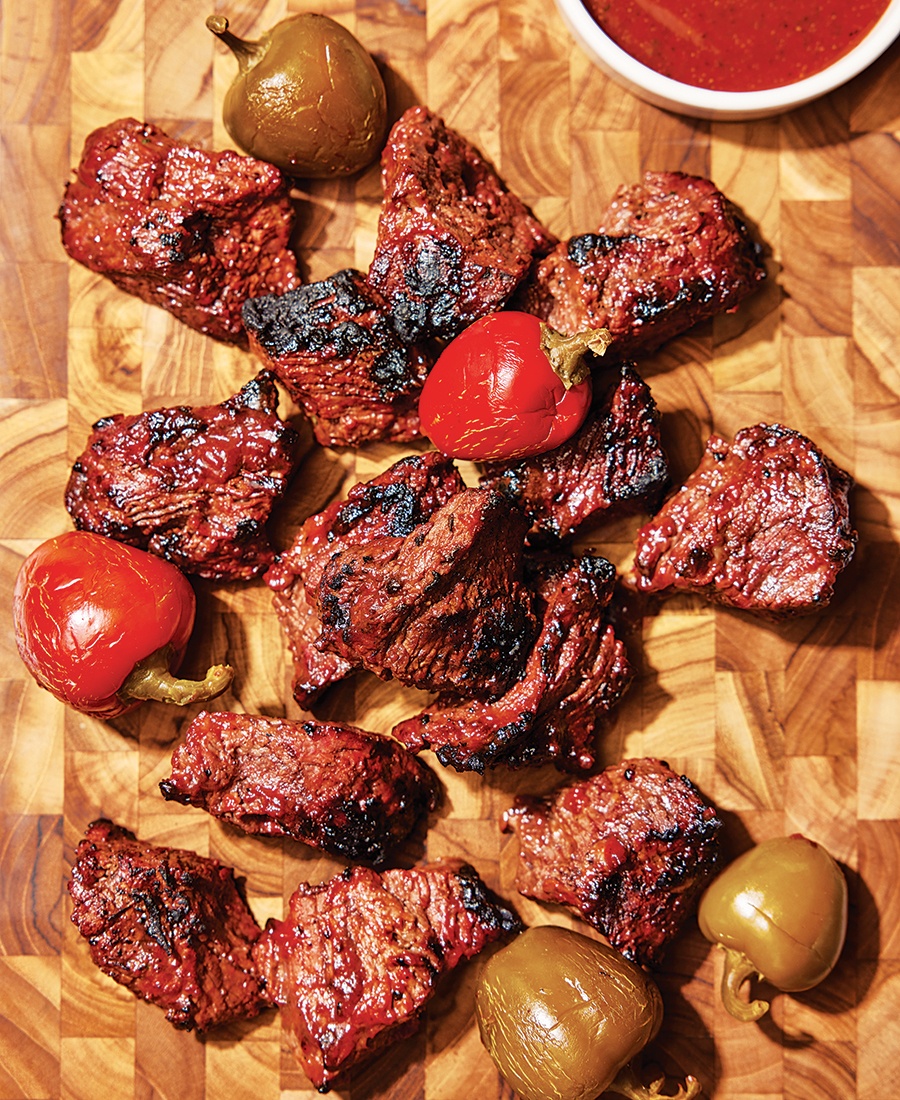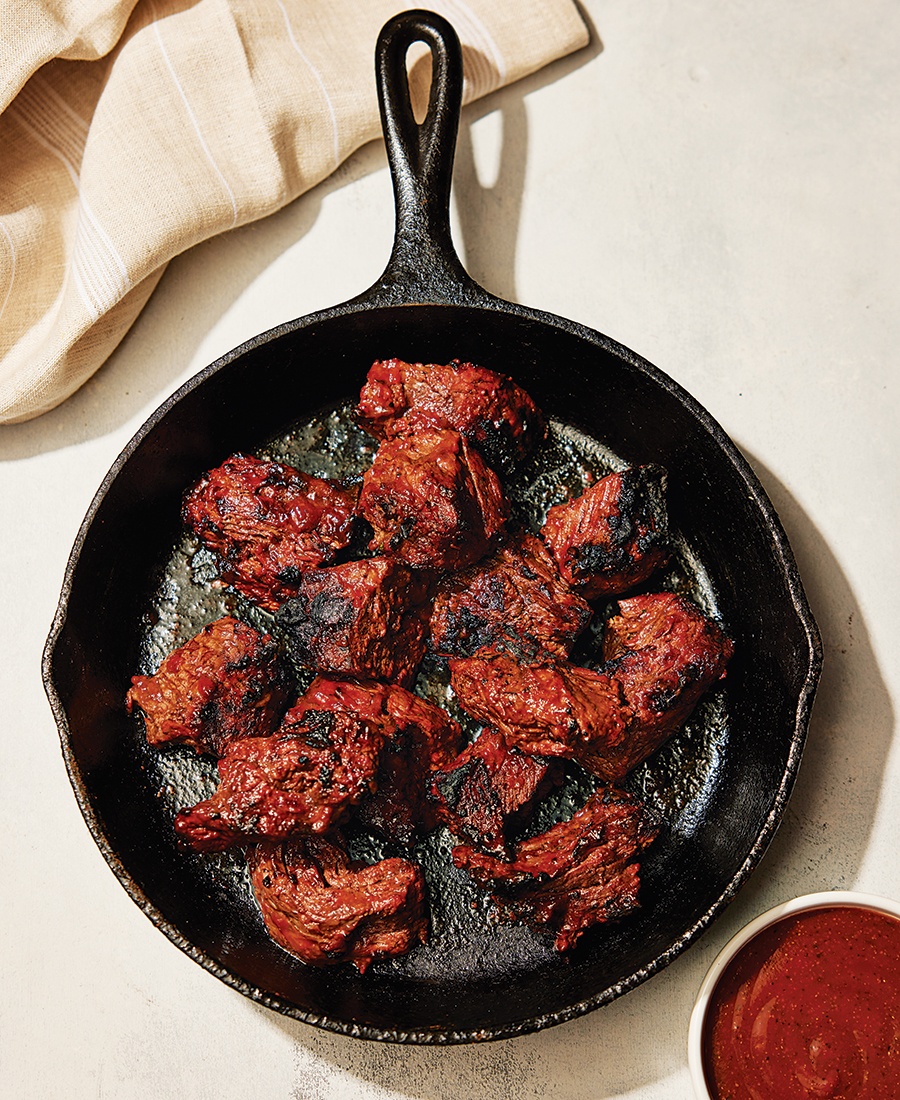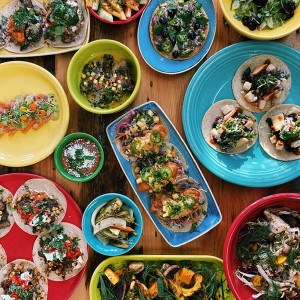The Mysterious Origins of Steak Tips, a Uniquely New England Dish
We spoke with two dozen chefs, culinary historians, and butchers to get to the bottom (sirloin) of it.

When it comes to steak tips, NewBridge Cafe in Chelsea has perfected the art of the char. / Photo by Joe St. Pierre
It’s just before 8 p.m. on a Wednesday, and I’m at a restaurant north of Boston that could be any New England sports bar and “grille.” It’s a quiet night, and the bar is emptier than I expected as some game or another is on the TV, providing the soundtrack for the intense wave of nostalgia that’s about to hit. I open up a gold-wrapped pat of butter and hopelessly attempt to spread it onto a piece of nondescript white bread. Soon, I’ll let a second pat dissolve onto my hot-as-lava baked potato after I burn my fingers tearing open its aluminum-foil jacket. Mediocre bread and singed fingertips be damned: It’s all part of the experience.
The server arrives—you know the type. She’s worked here forever, she has a Boston accent, she calls you “hon,” and she’s carrying a white plate piled high with beef, cut into chunks of about three or four bites each, glistening with the sheen of a marinade and branded with the char of the grill. To the side, a small bowl holds plump cherry peppers, some bright red and some olive green, all with an unexpected bite. Still, they’re just the supporting characters: I’m here for the steak tips.
There’s a knife, but it’s hardly necessary. One bite of the juicy, tender beef marinated in a sweet-and-smoky sauce, and the memories come rushing back: simple summer dinners cooked on a patio grill and served with a side of rice pilaf. For others, it might be tailgating, family cookouts, or nights out at a restaurant like this one. If you’re a New Englander, you know this steak. Yet one thing I’ve found by talking about steak tips (and I’ve had a lot of conversations about steak tips recently) is that most people from outside the region have never heard of them, and many people who live here don’t realize they’re a regional dish unique to this part of the country. Which raises the question: What even is a steak tip, anyway?
Further reading:
- The Ultimate Guide to Greater Boston’s Tastiest Steak Tips: New-school and old-school picks. Plus, international dishes to try if you like tips.
- How to Cook New England Steak Tips at Home: How to shop for, marinate, cook, and serve steak tips. Plus, recommended wine pairings.
- A Steak Tip Timeline: A cheat sheet to one or two possible histories of the steak tip.
First, there’s the cut of meat to consider. For some, that part of the equation is simple: “The only New England steak tip is sirloin flap meat,” says Tom Doyle, a fourth-generation co-owner of Alpine Butcher in Lowell, which has been open for a century. “Nothing else is it.” The cut, located in the bottom sirloin near the flank of the cow, used to be considered undesirable, he says, typically used for stew beef or ground meat (you’ll almost certainly never find steak tips on the menu at high-end steakhouses, though some serve flap meat under the fancy-sounding name “bavette,” often in the form of steak frites). Others say multiple cuts of meat can be considered a steak tip. “People have used flap meat, peeled knuckles, tri-tips—anything they want to cube and marinate,” says Ron Savenor, who owns Savenor’s Butcher & Market in Cambridge and Boston. Hanger steak is another good tip candidate, notes Maggi Healey, who works for the meat distributor T.F. Kinnealey & Co. Still, the best cut is flap meat, she says. “It’s sort of a fibrous meat, but it’s also tender. It’s very flavorful.”
Indeed, most butchers and chefs in New England agree that flap meat is the best cut, if not the only cut, for the job: It really takes to a marinade, which is another key part of the steak-tip equation, whether a sweet barbecue-style concoction or a simple Italian dressing. This is thanks to its “long, loose grain,” says Michael Dulock, owner of the Somerville butcher shop M.F. Dulock Pasture-Raised Meats. Whatever the cut or the marinade, though, one thing is certain: Whether you eat your tips at some dimly lit sports pub north of Boston or grill them at home, whether you throw them on a sub and slather them with melted cheese or toss them with some iceberg lettuce and call it a salad, you’re enjoying a true regional delicacy. In fact, if there’s one thing New Englanders love as much as drinking Dunkin’ iced coffee in the dead of winter, it’s eating steak tips.
Yet who, exactly, came up with them, and where and when? My search to find answers took me from the cozy sports-bar vibes of Chelsea mainstay NewBridge Cafe to the hallowed halls of Harvard University, where I pored over the fragile pages of more than a dozen New England cookbooks from the 19th and 20th centuries—not to mention a big box full of meat pamphlets. I spoke with chefs and owners of restaurants, both fancy and casual, as well as meat distributors, butchers, and food historians with a specialty in New England cuisine. I ate more beef in the span of a few weeks than could ever be advisable. And I did it all in a quest to discover exactly how this mysterious local tradition began.
Talk to local food experts, and they’ll all tell you a version of the same thing: The rise of the steak tip in New England was undoubtedly all about economics. How can you jazz up an undesirable cut of meat and make it profitable? Well, it turns out the magic is in the marketing (and maybe the marinade).
In the era before steak tips, flap meat was a troublemaker, an extra bit of something that butchers had to figure out what to do with. A single, average-sized steer produces merely 6 pounds or so of the stuff, so more often than not, it ended up getting thrown into the grinder to make hamburger meat, which “is the lowest-cost return on the animal other than bones or fat,” notes Dulock, who runs his Somerville butcher shop with a “nose-to-tail” ethos. “So if you can find something to do with it that people actually like to eat, then you can increase the return on that carcass.”
Doyle has a similar take. Up until the early 1970s, he says, local butchers were still bringing in whole sides of beef to carve up on-site, which meant they were only getting those few pounds of flap meat per steer. Around the mid-1970s, though, larger slaughterhouses started processing the sides of beef at their own facilities and shipping out individual cuts to butchers by the box. That’s when those big slaughterhouses had to figure out how to market less-desirable cuts like flap meat on a larger scale.
Market it they did: It turns out flap meat could be successfully sold as a cheap steak that’s good for grilling. By the 1980s, Doyle says, customers could readily buy sirloin flap meat from butchers and grocery stores. “Everything boils down to economics,” Dulock says. “At some point, somebody was cutting beef, couldn’t make money on that cut, and saw an opportunity to get more for it.” Or, as New England culinary consultant Lou Greenstein puts it, “A smart butcher said, ‘What can I call this to turn this cow into a Cadillac?’”
That might explain the rise of flap meat on a larger scale, but what of New England steak tips in their marinated, cherry-pepper-accompanied glory? The tips invention timeline is murky, with no one person publicly taking ownership of the idea, but as I soon discovered, there are plenty of theories.

Steak tips taste best when they’re prepared on high heat. / Photo by Joe St. Pierre
On a drizzly morning not too long ago, I went to Harvard on a mission to dig up the true origin story of the steak tip. Ducking into the Schlesinger Library at the Radcliffe Institute, known for its extensive collection of old cookbooks, I didn’t know exactly what I would find—the online search I’d done a few days earlier had come back nearly empty for “steak tips” and similar terms—but I figured I’d spend an hour or so scouring the archives for beef cooking trends over the centuries and poking around for any possible steak-tip precursors.
After securing my belongings in a locker downstairs, I made my way to the reading room, where a librarian wheeled over a cart full of the books that I’d requested. Leafing through them, I did find the phrase “sirloin tip” used in the 1935 cookbook Six Hundred Suggestions for Serving Meat by Alice Bradley, principal of Miss Farmer’s School of Cookery in Boston. Between sirloin roll and short-rib suggestions were two sirloin tip ideas—one with mushroom sauce and baked tomatoes stuffed with green pepper and onions, and one with horseradish, grated or shredded in leaves of lettuce.
Later in the same book, Bradley included notes on charcoal- or coal-broiling meat—and on that same page gave a brief “meat en brochette” recipe for meat broiled on steel skewers with pieces of bacon or salt pork (more on that in a moment). Soon, though, I realized that while it had been a fascinating trip through culinary history, I wasn’t going to find what I was looking for. After all, the steak tip’s origin story probably wasn’t hidden in musty cookbooks. It was likely to be found on old local restaurant menus.
The next day, I dialed up Marc Sheehan, chef and co-owner of Northern Spy in Canton and a New England culinary history buff with a large collection of “weird old menus,” as he calls them—and sure enough, he had a theory: Steak tips were likely a collision between two popular 20th-century menu items. Back in the 1940s, he told me, a dish called beef en brochette (essentially beef on skewers) often appeared on menus at nicer Boston restaurants. By the mid-1970s, the word “tips” started to appear in the dish name with some regularity: such as brochette of tenderloin tips and beef tips en brochette with rice pilaf. Some of the en brochette dish descriptions even mention marinades, including a 1976 version from Hampshire House on Beacon Hill: “cubes of beef marinated in a special sauce, skewered with onion, peppers, tomatoes and mushroom and served on a bed of rice.” (Priced at $5.95 at the time, if you want to feel a little depressed.) But wait, doesn’t that sound like a kebab of some kind?
Kebabs, indeed. In the 1970s, there was a wave of Greek immigration to New England, and a lot of Italian restaurant owners began selling their businesses to recent Greek immigrants, leading to a rise in pizzerias selling dishes such as kebabs and souvlaki (and that special genre of pizza, New England Greek). “Kebabs and souvlaki are just steak tips,” Sheehan said, and “in an effort to appeal to the American palate,” restaurant owners may have started swapping out a more Greek-style marinade (lemon, garlic, and olive oil) for something like Worcestershire. The sauce’s sweet-tinged umami isn’t too far off from the sweet barbecue-style marinade we now know and love. Over time, Sheehan continued, the two dishes “naturally evolved” into the current iteration of steak tips. It’s as likely a theory as any, but as Sheehan admitted, there’s typically parallel evolution when it comes to the origin stories of regional foods. So how else might the modern steak tip have come to be?
In the multiverse of New England steak tips, a parallel timeline likely started at everyone’s favorite 68-foot-tall cactus on Route 1 in Saugus. Many people I spoke with believed Hilltop Steakhouse, at one point America’s highest-grossing restaurant, to be the inventor—or at least the popularizer—of the dish. It makes sense, given that the massive (and massively popular) North Shore icon, open from 1961 to 2013, was a pioneer in the Greater Boston restaurant world, particularly when it came to steak.
One believer in the Hilltop origin story is George Ravanis, owner of Frank’s Steak House in Cambridge, which first opened in 1938. “Hilltop slaughtered their own meat and cut everything up, and they just found a use for a not-that-used part of the cow, the flap meat,” Ravanis said. “Everything is done out of necessity.” He compared it to the creation of tater tots by the frozen food company Ore-Ida (what to do with the leftover bits of potatoes from French-fry production?) or Buffalo wings at Anchor Bar in Buffalo, New York, where co-owner Teressa Bellissimo found a way to popularize the previously undesirable chicken wing thanks to the magic of deep-frying and hot sauce.
After speaking with Ravanis, I decided to head straight to the source—and, indeed, Gina Giuffrida, daughter of the late Hilltop founder Frank Giuffrida, confirmed that tips were on Hilltop’s menu from the very beginning—grilled, but unmarinated, with a choice of fries, rice, or potato, plus a “ginormous” salad, she said. After comparing notes with her mother, sister, and other family members, she believes her father, who was born in 1917 and lived through the Great Depression, did create the steak tip. “He would never waste a cut of meat,” she said. “If there was something he could utilize, he utilized it.” When the Hilltop Butcher Shop opened later in the 1960s, he sold the tips in 5-pound bags. “I know we were the first retail store to sell steak tips,” Giuffrida told me, “One hundred percent.”
Still, that doesn’t explain where the iconic marinade came into play. Several of my sources pointed me to the next stop on my steak-tip investigation: a bustling restaurant in a blocky brick building in Chelsea. NewBridge Cafe, which opened in 1975, still serves some of the region’s most beloved tips (more than 1,000 pounds every week). Yet, when I talked to John Mandracchia, the restaurant’s second-generation co-owner, he wasn’t willing to take the credit. “I don’t think we originated it, but we’re pretty close to the beginning,” he said. His guess? The Ninety Nine restaurant, sometime in the 1960s.
Lore at the Ninety Nine—whose original downtown Boston location opened in 1952—does suggest that the chain may have been the birthplace of the marinated tip, at least of the Italian dressing variety. Michelle Giovine, vice president of marketing for Ninety Nine Restaurants & Pub, said that the story, passed down over the past 50 years, is that steak tips initially appeared on the restaurant’s menu at the company’s first suburban location outside of Boston, in Lynnfield. There, as legend has it, a cook accidentally knocked steak trimmings into a bowl of Italian dressing. “Never wanting to waste usable food, the staff decided to sell the marinated beef cuts as a special,” Giovine shared. “Guests loved them, and the rest is history.”
The timeline is unclear, but the Ninety Nine team showed me two menus, one from 1971 and one undated but assumed to be pre-1971 based on the number of locations on the back, each including marinated tips. For $4.99, a diner could get 9 ounces of “charcoal broiled beef tips” that were “lightly marinated” and served on rice pilaf. (Giovine described the current marinade as “an Italian-style blend of spices” that gives the beef “a unique and robust flavor.”) Giovine doesn’t go so far as to say that the Ninety Nine introduced steak tips in New England but asserted that “no brand has been more instrumental in making them the popular offering for the region.” Steak tips, she said, continue to be one of the chain’s most popular items.
The final step in the mysterious steak-tip timeline? Marinated tips sold to home cooks. Malden-based Dom’s Sausage Co.—makers of “the official steak tip of the New England Patriots,” which might win the award for the most New England phrase ever uttered—is certainly at the forefront, if not the creator. Today, siblings Elizabeth Botticelli, Melanie Botticelli Fusco, and Domenic Botticelli are third-generation owners, but the company dates to 1936, when their grandfather Domenic started making sausages in his mother-in-law’s basement.
When Dom’s opened its current Malden storefront in the 1970s, steak tips weren’t in the picture just yet. Then, during the early 1980s, when the government began ramping up its war on saturated fat and cholesterol, second-generation owner Angelo “Buddy” Botticelli was eager to tempt the masses back to the meaty side, according to Fusco. “He said, ‘Let’s get some beef and flavor it up and make it different.’” Botticelli and a friend, who made flavors for the sausages, came up with Dom’s original steak-tip marinade, a secret recipe that touts its smoky and sweet caramel flavors.
At first, the Dom’s team marinated meat in big vats, bagging and weighing it to order. This turned out to be a messy, sticky method, so they purchased machinery to package the tips, leading to mass production. Today, Dom’s sells to more than 100 wholesalers and ships to customers nationwide. New England expats are often the ones ordering the tips from afar, says Elizabeth Botticelli, who serves as president of the company and director of shipping. “I get so many emails saying, ‘I need my Dom’s.’ They say there are no steak tips in places like Florida or Idaho or California or Texas.”
The truth is, no one knows quite why steak tips have remained fairly close to New England all of these years, but locals will fiercely defend them and loyally promote their favorites. Whether the kebab/brochette theory or the Hilltop/Ninety Nine/Dom’s theories ring more true, the origin story remains an elusive mystery—a big, beefy question mark.
Still, in the end, maybe the when, where, and who matter less than the why. Why are steak tips such a uniquely New England thing? Two words popped up consistently during my conversations when it comes to our love affair with steak tips: New Englanders are “frugal,” and New Englanders are “hardy.” We’re drawn to meat, the premise goes, that represents making something usable—better than usable, really—out of something others would discard. And yes, New Englanders are perfectly willing to grill meat outdoors year-round, even standing in a foot of snow. “I think in New England, people are hard-working,” Elizabeth Botticelli says. “We can be casual, we can be formal, and steak tips give a more casual vibe to a steak dinner. You can dress them up with a nice veggie or potato, or you can smother them with cheese and put them in a big sub roll, and you have a nice on-the-go ‘sangy.’ It’s a steak, and it’s a sandwich. You got a problem with that?”
Steak Tips: A Timeline
1940s
Skewered “en brochette” dishes, including various grilled cuts of beef, begin appearing on restaurant menus throughout Boston.
1961
Hilltop Steakhouse opens in Saugus, touting grilled but unmarinated steak tips on its menu from the start.
Late 1960s
Hilltop opens a butcher shop that sells unmarinated steak tips.
1970s
A wave of Greek migration into Greater Boston leads to Greek-run pizzerias/sub shops serving souvlaki and kebabs—a dish some believe collided with “en brochette” dishes to create the steak tips New Englanders know and love today.
1971 (or earlier)
The growing Ninety Nine restaurant chain starts serving marinated tips.
1975
NewBridge Cafe opens in Chelsea, serving marinated steak tips. The phrase “steak tips” begins to appear on more menus in Greater Boston.
1980s
Dom’s Sausage Co. in Malden begins selling packaged, marinated tips. More restaurants, such as Frank’s Steak House in Cambridge, also begin serving marinated tips.
Today
Steak tips are prevalent on menus at casual restaurants throughout Greater Boston and other corners of New England. Most local butcher shops and larger grocery stores sell them, ready to cook, in a variety of marinades.
First published as part of a feature in the print edition of the May 2023 issue with the headline “Long Live Steak Tips!” See also: a guide to Greater Boston’s best old-school and new-school steak tips and a guide to shopping for, marinating, cooking, and serving steak tips.





